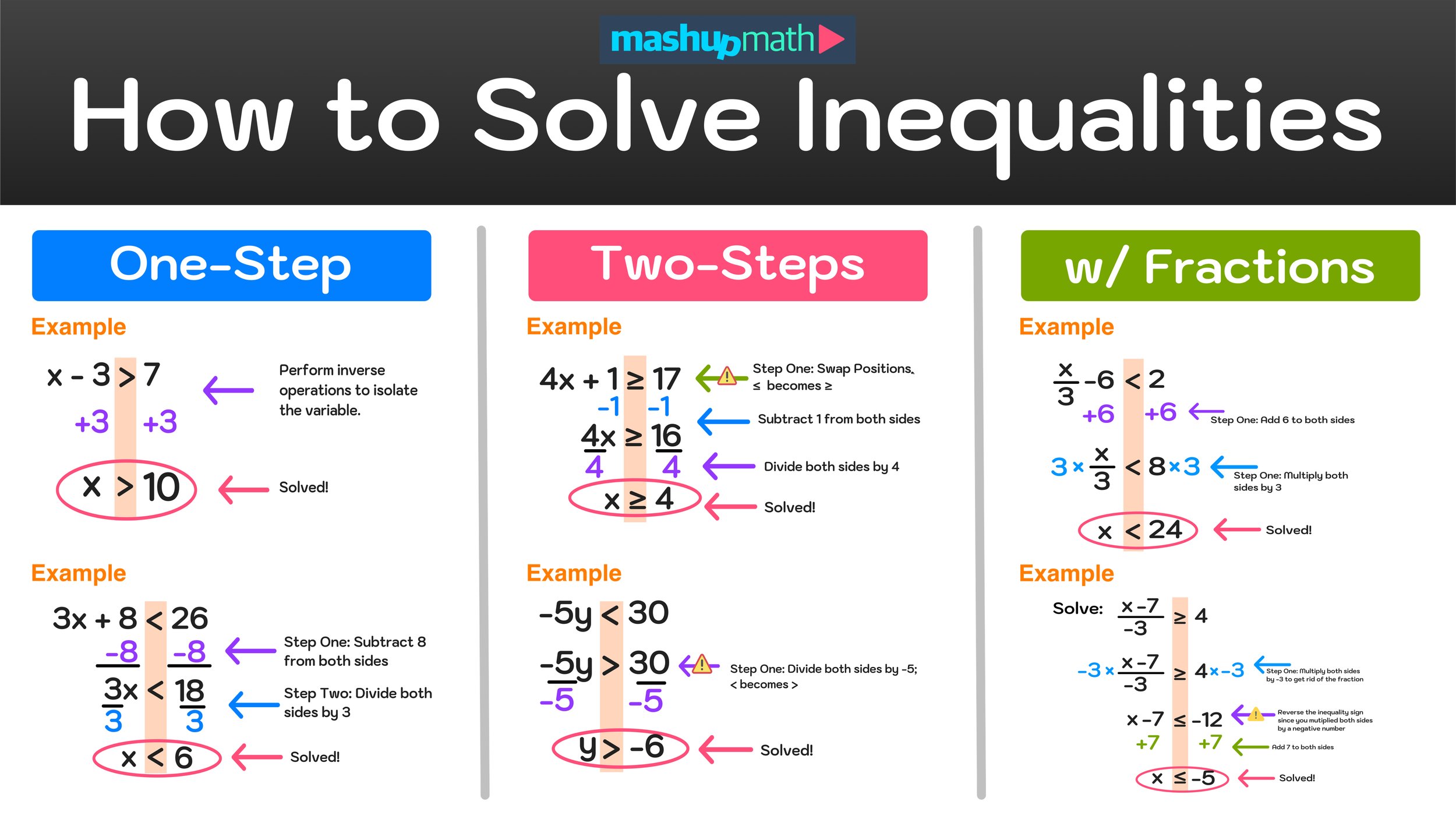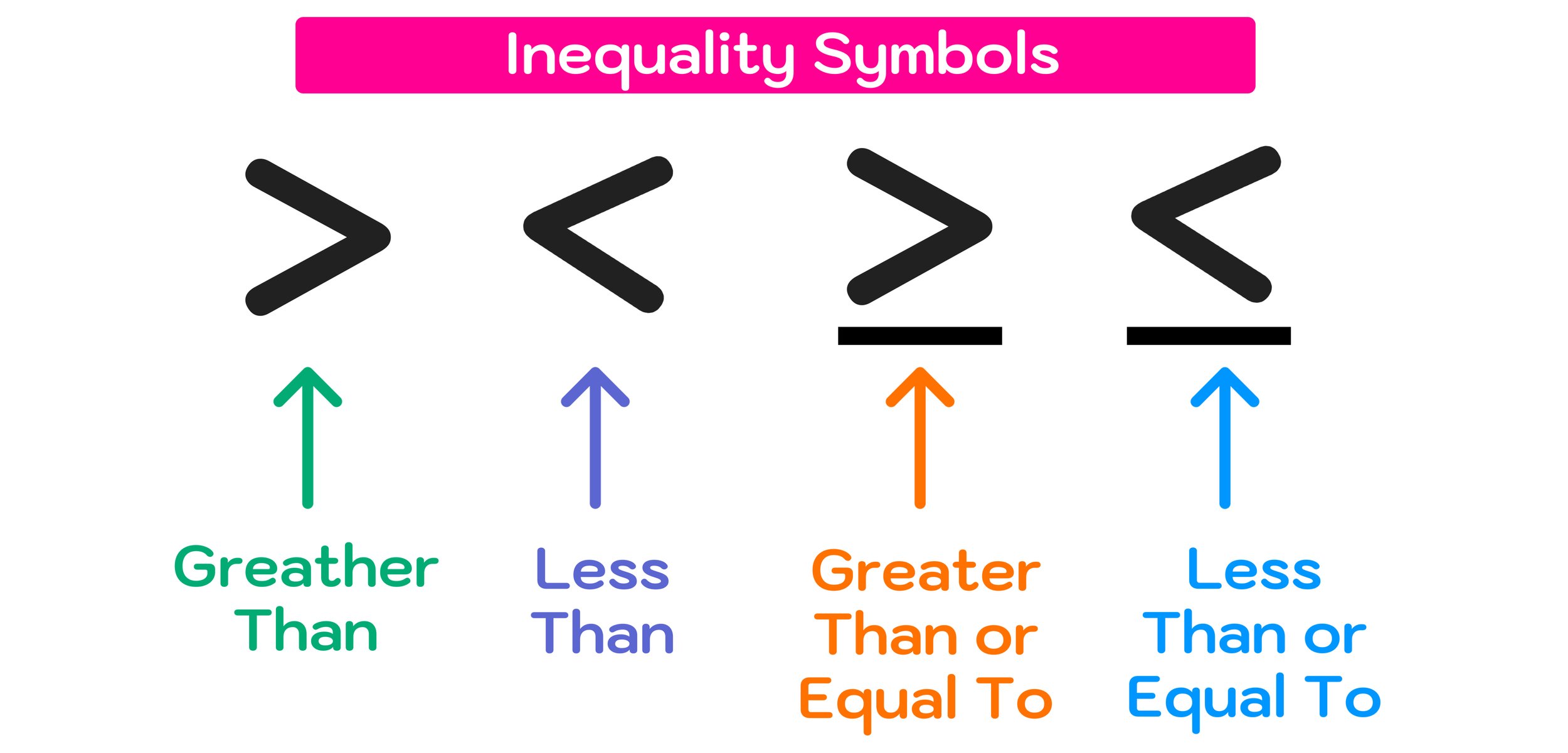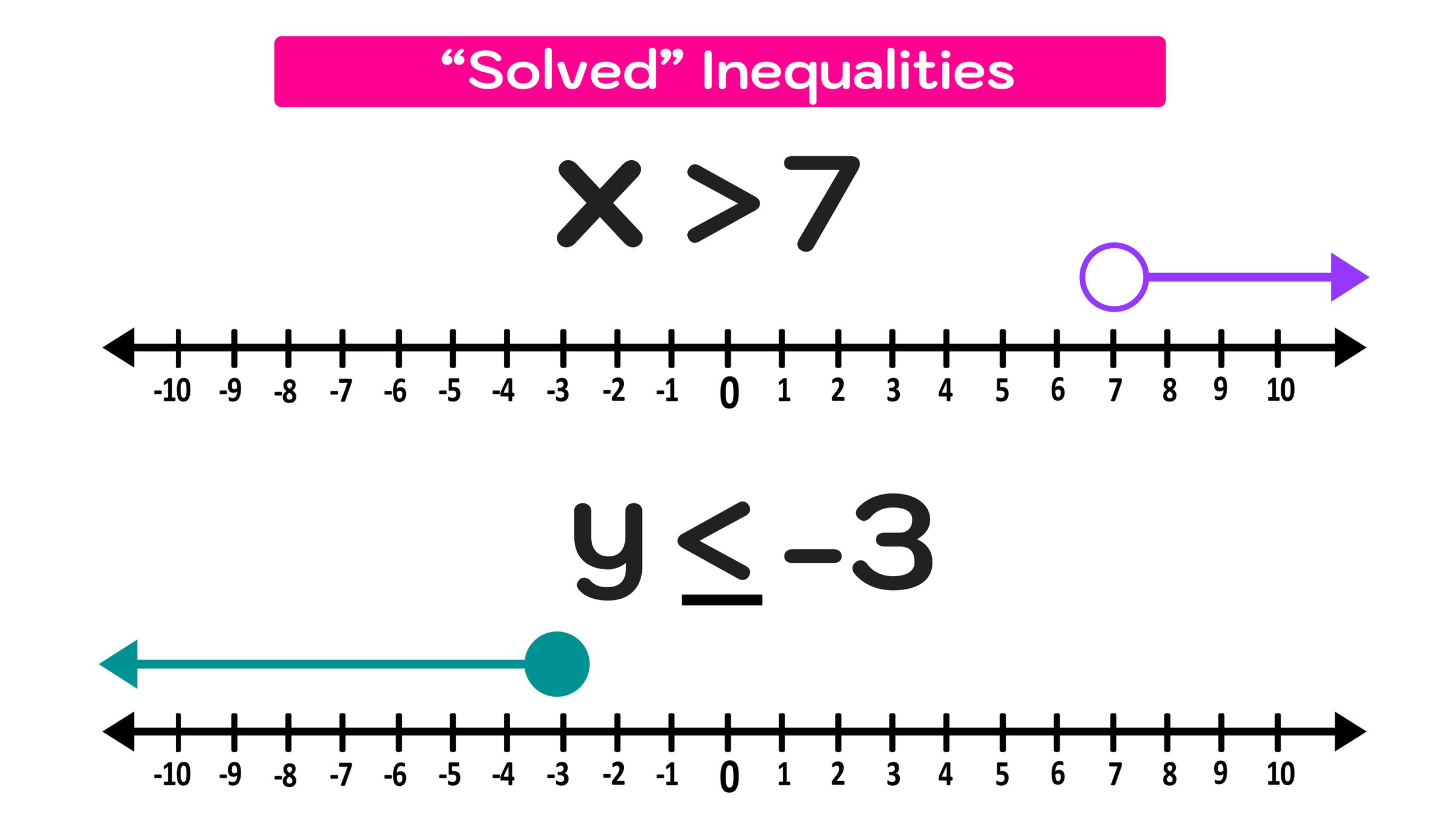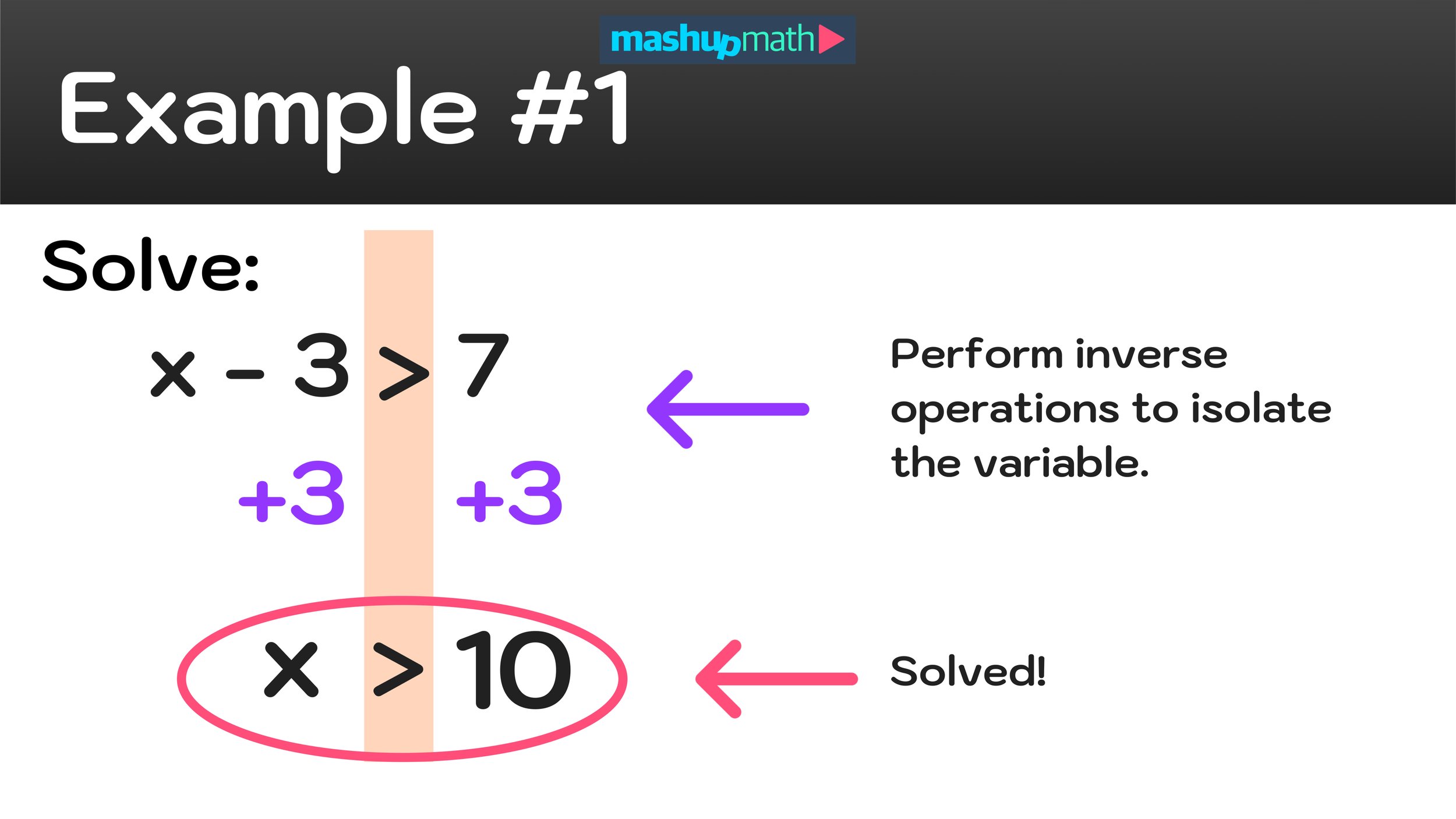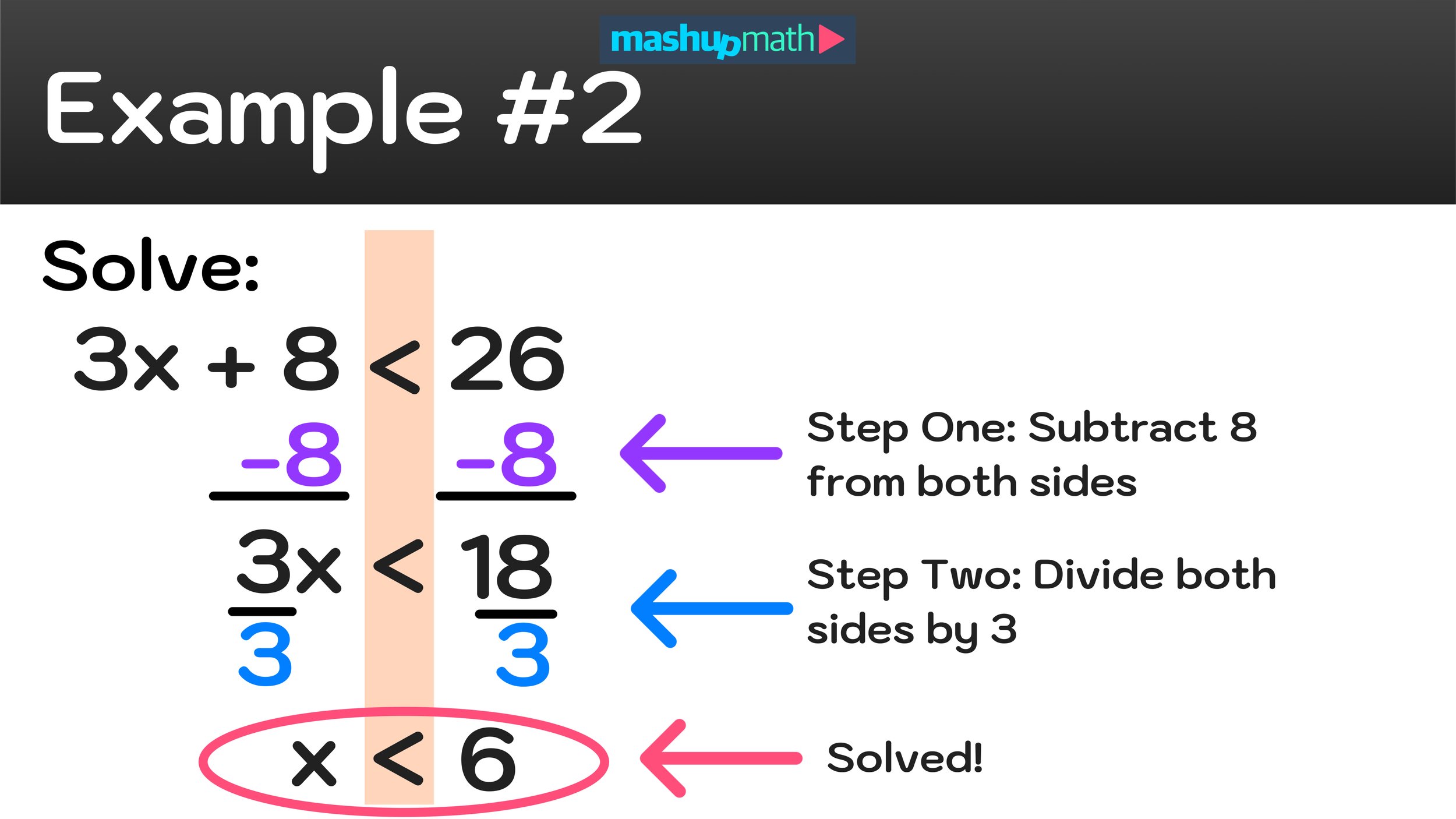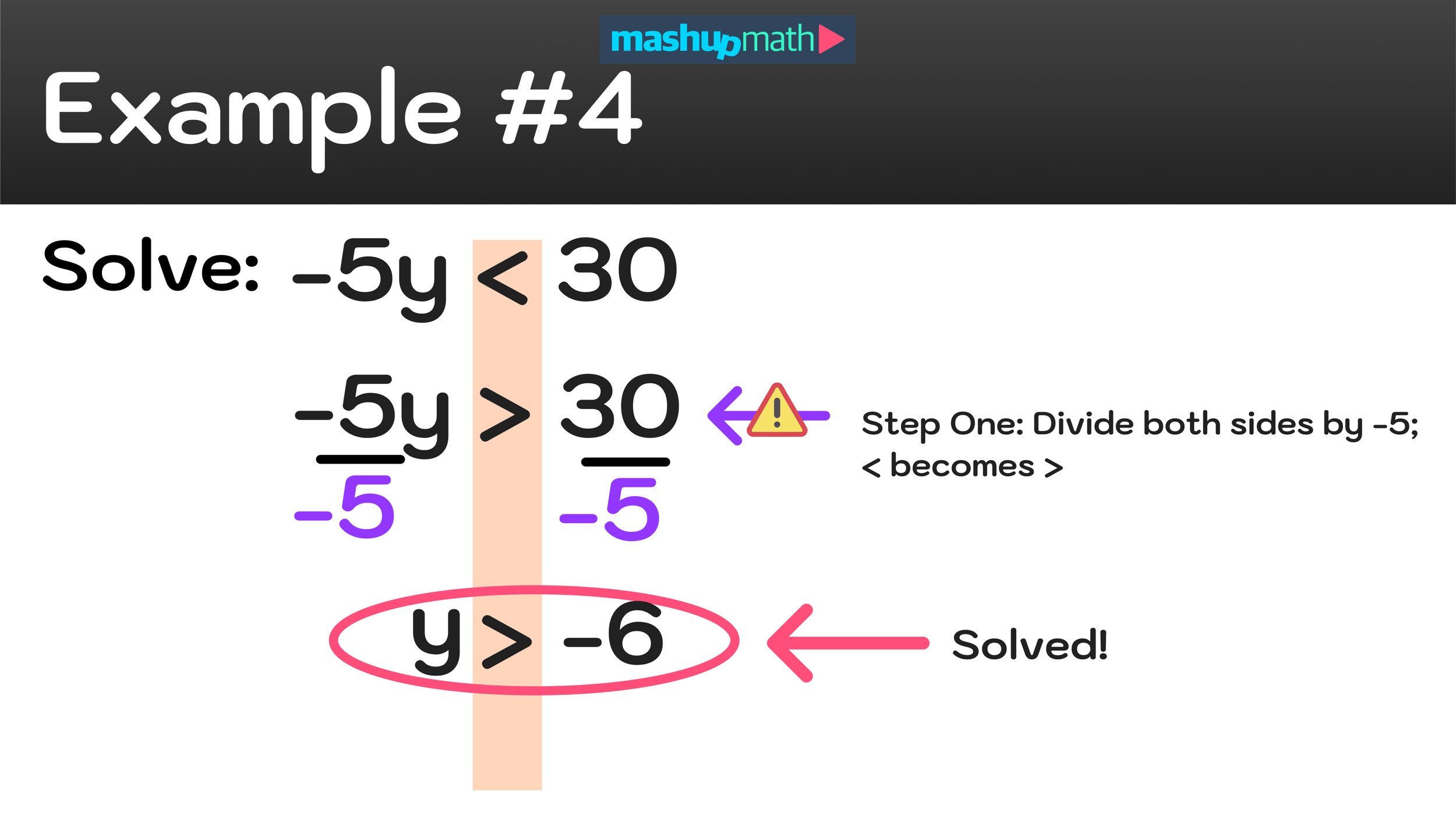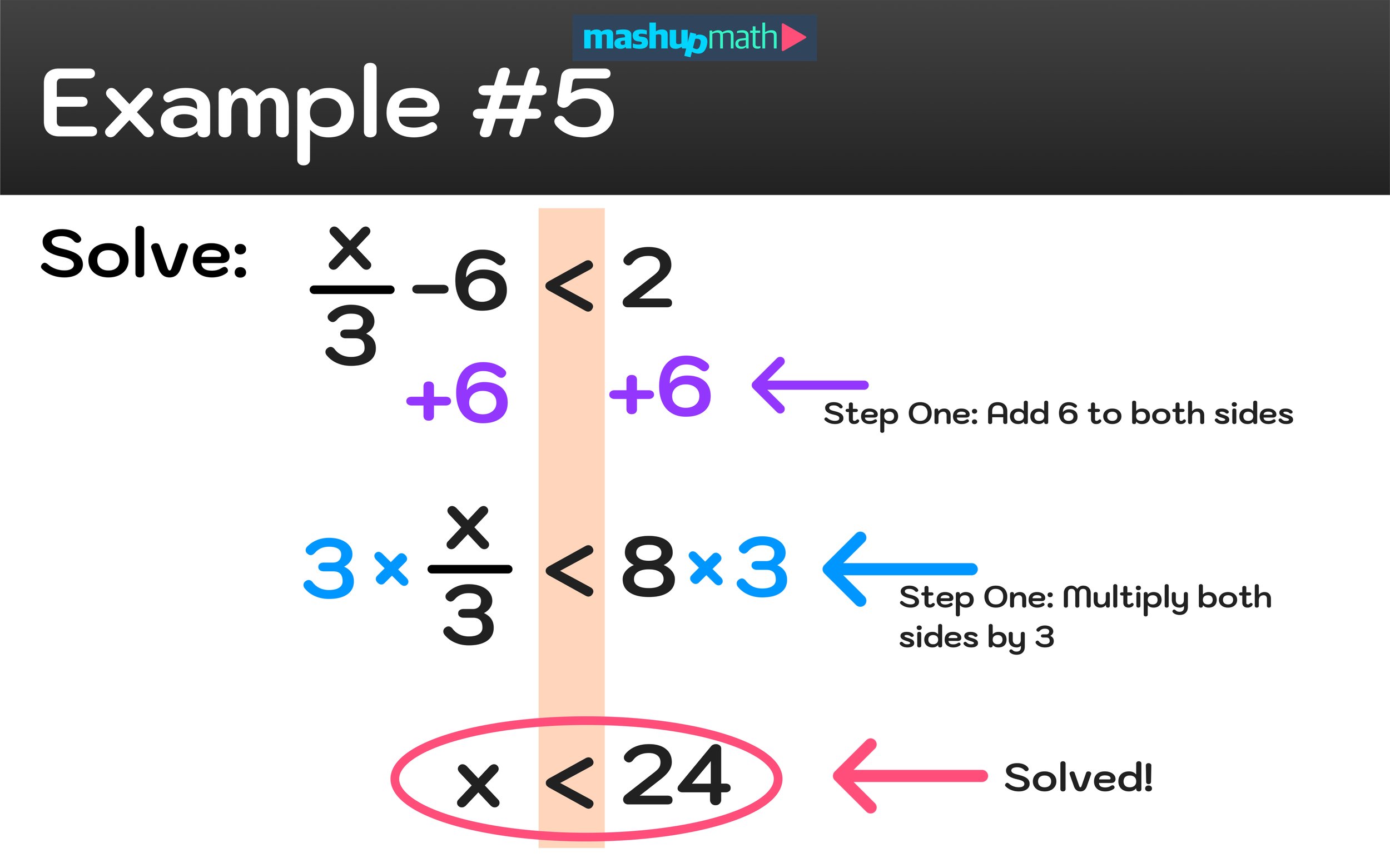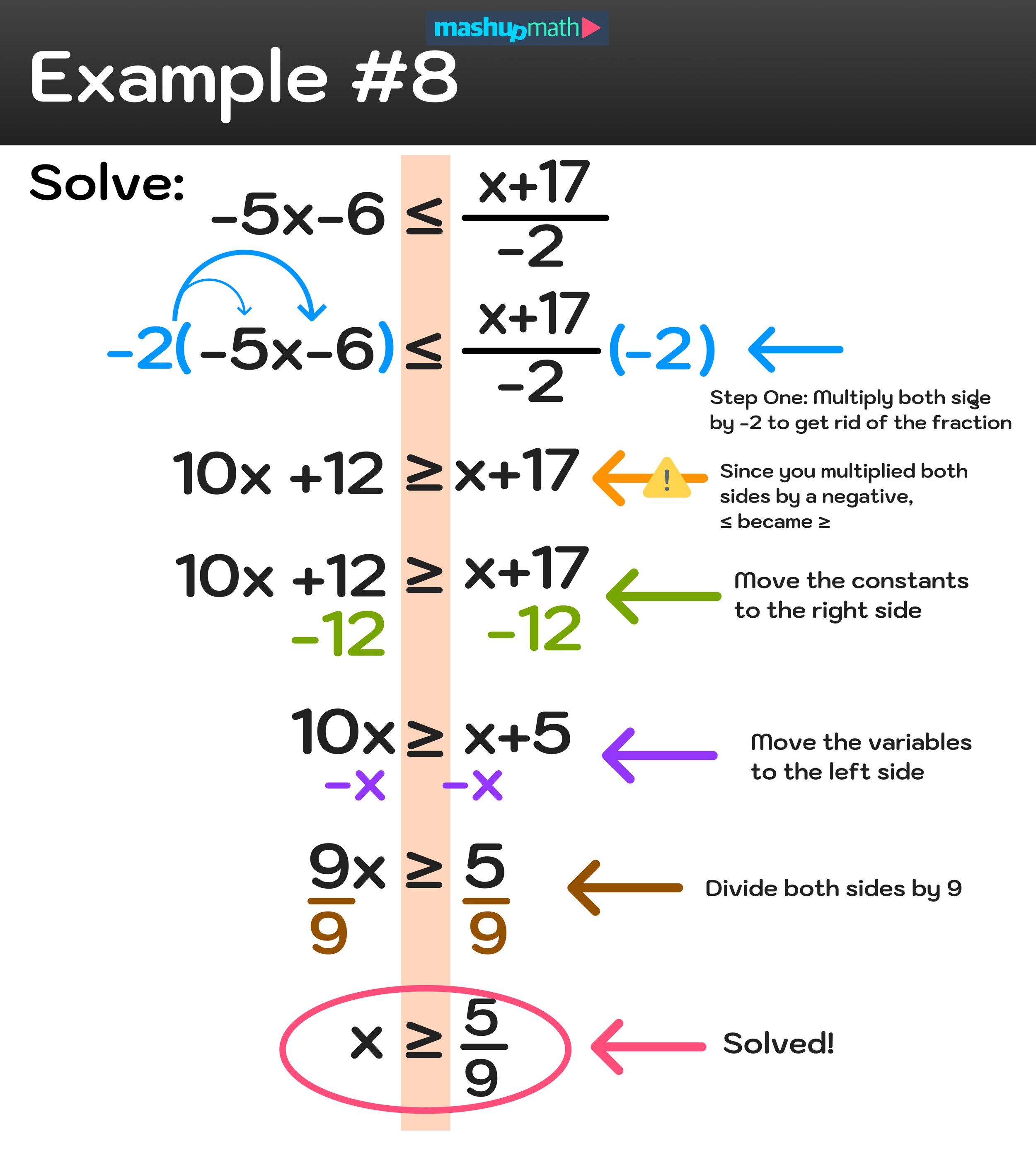How to Solve Inequalities Explained
Step-by-Step Guide: How to Solve an Inequality Equation
In math, an inequality is a symbol that is used to represent the relationship between two values or expressions that are not necessarily equal to each other. There are four types of inequality symbols:
> : greater than
< : less than
≥ : greater than or equal to
≤ : less than or equal to
Understanding how to solve inequalities is an important math skill that all students will need to be successful in algebra and beyond. To acquire this skill, you will have to build upon your knowledge of solving equations and extend that understanding to solving inequalities.
This free Step-by-Step Guide on How to Solve Inequalities covers the following:
While learning how to solve an inequality is a little trickier than learning how to solve an equation, you can easily learn how to solve inequalities by working through this guide. By working through the step-by-step practice problems below, you will gain plenty of helpful practice with solving inequalities, which will put you on the path of being able to solve any inequality with ease.
While you are probably eager to dive into a few practice problems, let’s start off with a quick review of a few key vocabulary terms that you should deeply understand before you begin learning how to solve an inequality.
Figure 01: There are four types of inequality symbols: > : greater than, < : less than, ≥ : greater than or equal to, and ≤ : less than or equal to.
What is an inequality?
As said earlier, in math, an inequality is a relationship between two values or expressions that are not equal to each other. Because the values or expressions are not equal to each other, we have to use an inequality sign instead of an equals (=) sign.
You already know that there are four types of inequalities: > : greater than, < : less than, ≥ : greater than or equal to, and ≤ : less than or equal to (these four types of inequalities are illustrated in Figure 01 above).
Basic inequalities do not need to be solved since the variable is already by itself.
For example, consider the inequalities x>7 and y≤-3.
These inequalities can be thought of as solved because the variables are already on their own. These “solved” inequalities are illustrated in Figure 02 below.
Figure 02: How to solve inequalities. What do solved inequalities look like?
But, what if we had an inequality that looked like this: x - 3 > 7
Since the variable, x, is not by itself, this inequality still needs to be solved, and the remainder of this guide will show you exactly how to do that.
Now that you are familiar with the key vocabulary terms, it’s time to look at a few examples.
How to Solve Inequalities Example #1
Example: x - 3 > 7
Just as you would solve an equation, to solve an inequality, you must use inverse operations to isolate the variable, which, in this example, is x.
You can isolate x easily by adding 3 to both sides of the inequality sign as follows:
x - 3 > 7
x -3 + 3 > 7 +3
x > 10
Now the inequality is solved! The answer is x>10. The step-by-step procedure to solving this first example is illustrated in Figure 03 below.
Figure 03: How to solve an inequality: x-3>7
This first example of how to solve inequalities was relatively simple and only took one step to solve. Now, let’s move onto solving a slightly more difficult inequality.
How to Solve Inequalities Example #2
Example: 3x + 8 < 26
Again, to solve the inequality you have to isolate the variable x by performing inverse operations as follows:
3x + 8 < 26
3x - 8 < 26 - 8
3x < 18
3x/3 < 18/3
x < 6
Solving this example required two steps (step one: subtract 8 from both sides; step two: divide both sides by 3). The result is the solved inequality x<6.
The step-by-step procedure to solving example #2 is illustrated in Figure 04 below.
Figure 04: How to solve an inequality: 3x+8<26
When Do Inequality Signs Reverse Directions?
The first two examples of solving inequalities are considered basic and they can both be solved in two steps or less.
However, more complex inequalities can include instances when the inequality sign will reverse direction in one of the following ways:
> becomes <
< becomes >
≥ becomes ≤
≤ becomes ≥
So, when do you have to worry about reversing the direction of an inequality sign?
Let’s start by listing all of the instances when you are safe and do not have to change the direction of the inequality sign.
Whenever you add or subtract a number from both sides of the inequality
Whenever you multiply or divide both sides of the inequality by a positive number
Both of these cases occurred in examples #1 and #2, which is why we did not have to change the direction of the inequality sign.
However, you do have to change the direction of the inequality sign under these instances:
🔄 Whenever you swap the position of the left side of the inequality with the right side of the inequality
🔄 Whenever you multiply or divide both sides of the inequality by a negative number
These rules are illustrated in Figure 05 below.
Figure 05: When do inequality signs reverse direction?
Now, let’s take a look at a few examples of solving inequalities where you will have to reverse the direction of the inequality sign.
How to Solve Inequalities Example #3
Example: 17 ≤ 4x + 1
This example is a bit different because the variable, x, is on the right side of the equal sign and we typically express solved inequalities with the variable on the left.
You can still solve this problem the same way that you solved example #2, but first you must swap the left side of the inequality with the right side. However, remember that swapping the position of the left side and the right side requires you to also reverse the direction of the inequality as follows:
17 ≤ 4x + 1 ➙ 4x + 1 ≥ 17
⚠️ Notice that the ≤ reversed position to become ≥!
Now, you can solve 4x + 1 ≥ 17 as follows:
4x + 1 ≥ 17
4x + 1 -1 ≥ 17 -1
4x ≥ 16
4x/4 ≥ 16/4
x ≥ 4
The inequality has been solved and the final result is x ≥ 4.
The steps for solving example #3 are detailed in Figure 06 below.
Figure 06: How to solve an inequality when the variable is on the right.
Now that we have covered the first instance of when you have to reverse the direction of an inequality sign, let’s see an example of the second instance—Whenever you multiply or divide both sides of the inequality by a negative number.
How to Solve Inequalities Example #4
Example: -5y < 30
Solving this inequality will require only step to isolate the variable, y, on the left side of the inequality. However, since that one step involves multiplying or dividing by a negative number, you must also reverse the direction of the inequality sign as follows:
-5y < 30
-5y/-5 > 30/-5 (⚠️ since you divided by a negative, < becomes >)
y > -6
The inequality has been solved and the final result is y > -6.
The steps for solving example #4 are detailed in Figure 07 below.
Figure 07: How to solve an inequality when you have to multiply or divide both sides by a negative number.
How to Solve Inequalities with Fractions
Now that you have some more experience with solving inequalities and you know when you have to reverse the direction of the inequality sign, let’s take a look at two more complex examples that involve fractions.
How to Solve Inequalities with Fractions Example #5
Example: x/3 - 6 < 2
When it comes to solving inequalities with fractions, the same strategy as the previous examples will apply. To solve, you have to use inverse operations to isolate the variable on the left side of the equation.
And, if you have to swap the positions of the left and right sides of the inequality or if you multiply or divide both sides by a negative number, then you will have to reverse the direction of the inequality sign.
You can solve this inequality as follows:
x/3 - 6 < 2
x/3 -6 +6 < 2 + 6
x/3 < 8
3 x (x/3) < 3 x (8)
x < 24
The inequality has been solved and the final result is x < 24.
*Note that this example did not require you to reverse the direction of the inequality sign since you did not have to swap positions or multiply/divide by a negative number.
The step-by-step process for solving example #5 is shown in Figure 08 below.
Figure 08: Solving Inequalities with Fractions Example #5
How to Solve Inequalities with Fractions Example #6
Example: (x-7)/-3 ≥ 4
This next example is the most complex one we have seen so far, but our strategy of using inverse operations to isolate the variable remains the same.
You can solve this inequality as follows:
(x-7)/-3 ≥ 4
(x-7)/-3 x -3 ≥ 4 x -3 (multiply both sides by -3 to get rid of the fraction)
x-7 ≤ -12 (⚠️ because you multiplied both sides by a negative, ≥ becomes ≤)
x-7 +6 ≤ -12 +7
x ≤ -5
The inequality has been solved and the final result is x ≤ -5.
⚠️ Note that we did have to reverse the inequality sign from ≥ to ≤ because we multiplied both sides by negative 3.
The step-by-step process for solving example #5 is shown in Figure 09 below.
Figure 09: Figure 08: Solving Inequalities with Fractions Example #6
As we enter the last section of this step-by-step guide to solving inequalities, let’s take a look at two more multi-step examples. If you can solve these next two problems using the previously discussed strategies, then you will be able to solve almost any problem related to solving inequalities.
How to Solve Inequalities with Fractions Example #7
Example: -6 > (7y-5)/9
This example will require a few steps in order to isolate the variable x, but we can still used inverse operations to solve as follows:
-6 > (7y-5)/9 ➙ (7y-5)/9 < -6
⚠️ Notice that the variable, y, is on the right side of the inequality sign, so we will start by reversing the positions of the left side and the right side, which also means that we have to reverse the direction of the inequality sign.
(7y-5)/9 < -6
(7y-5)/9 x 9 < -6 x 9
7y-5 < -54
7y -5 +5 < -54 + 5
7y < -49
7y ÷ 7 < -49 ÷ 7
y < -7
The inequality has been solved and the final result is y < -7.
Note that we did not have to reverse the inequality sign because the number that we multiplied both sides of the equation by was a positive 9.
The step-by-step process for solving example #7 is shown in Figure 10 below.
Figure 10: Solving Inequalities with Fractions Example #7
How to Solve Inequalities with Fractions Example #8
Are you ready for one final example of how how to solve inequalities with fractions? This one is a little tricky, but you have all of the tools that you need to solve it as long as you take it step-by-step.
Example: -5x - 6 ≤ (x+17)/-2
The first thing that you are probably noticing is that there are x’s on both sides of the inequality sign. Since the goal is to isolate x on the left side of the inequality, you will have to use inverse operations to get x by itself.
Let’s start by getting rid of the fraction on the right side of the inequality by multiplying both sides by -2.
-2(-5x - 6) ≤ (x+17)/-2(-2)
To solve the right side of the inequality, you will have to use the distributive property to multiply both terms (-5x-6) by -2.
10x + 12 ≥ x+17 ⚠️
⚠️ And because we just multiplied both sides by a negative number, we had to reverse the direction of the inequality sign, so ≤ became ≥
Now we can continue solving this inequality by using inverse operations:
10x + 12 ≥ x+17
10x + 12 -12 ≥ x +17 -12 (move the constants to the right side)
10x ≥ x + 5
10x -x ≥ x -x +5 (move the variables to the left side)
9x ≥ 5
9x ÷ 9 ≥ 5 ÷ 9 (isolate x)
x ≥ 5/9
The inequality has been solved and the final result is x ≥ 5/9.
Note that it’s totally fine for our final result to be a fraction.
The step-by-step process for solving example #8 is shown in Figure 11 below.
Figure 10: Solving Inequalities with Fractions Example #8
Free Solving Inequalities Worksheet (w/ Answers)
Are you looking for some extra independent practice on how to solve inequalities and how to solve inequalities with fractions?
You can use the link below to download a free solving inequalities worksheet pdf file that includes a complete answer key. We recommend that you work through each problem on your own keeping this guide close by as a reference.
▶ Download your free Solving Inequalities Worksheet (One-Step) PDF
▶ Download your free Solving Inequalities Worksheet (Two-Steps) PDF
Preview: Solving Inequalities Worksheet PDF
While you work through the practice problems, keep the lesson summary main points below in mind.
Conclusion: How to Solve Inequalities
Like equations, inequalities can be solved by using inverse operations to isolate a variable on the left side of the inequality.
Solving an inequality by adding/subtracting numbers on both sides of the inequality or by multiplying/dividing both sides by a positive number does not result in a reversal of the inequality sign.
⚠️ On the other hand, swapping the positions of the left and right sides of an inequality or multiplying/dividing both sides by a negative number requires you to reverse the position of the inequality sign such that: > becomes <, < becomes >, ≥ becomes ≤, and ≤ becomes ≥
When solving inequalities with fractions or inequalities with variables on both sides, the process of using inverse operations to isolate the variable and solve remains the same, albeit with a few more steps involved.

